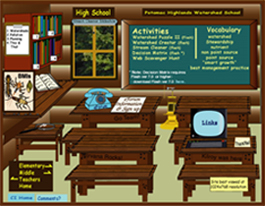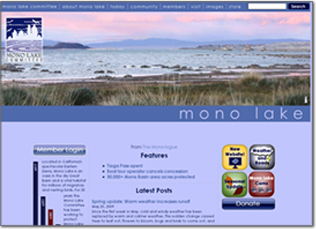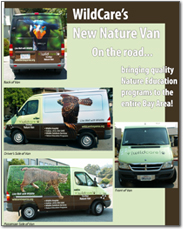Environmental Impact Winners: Other Media
First Place:
Potomac Highlands Watershed School
High View, West Virginia
Submission: Potomac Highlands Watershed School
Cacapon Institute works to protect the Cacapon River as it flows into The Potomac River and on into Chesapeake Bay through the use of science and education. The Potomac Highlands Watershed School is an eSchool website designed to encourage K-12 education of watershed issues and what actions can be taken to protect these critical natural resources. The eSchool was designed to look like an old-time, Appalachian schoolhouse to encourage and invite exploration by children in an educational environment, and includes interactive-learning activities such as Watershed Puzzle, Watershed Creator, Stream Cleaner, and Decision Matrix. While the eSchool is focused on the Chesapeake Bay region, it is used by schools free-of-charge throughout the world, including one teacher in Bangkok who used the Flash lessons in an English as a Second Language class.
Project Gallery Page
Organization's Website
Runners Up
Mono Lake Committee Website
Lee Vining, California
Submission: Mono Lake Committee Website
The Mono Lake Committee is dedicated to protecting and restoring the Mono Basin ecosystem, educating the public about the impacts of excessive water use on Mono Lake and the environment, and promoting cooperative solutions that protect Mono Lake and meet real water needs without transferring environmental problems to other areas. As part of the 2008 website redesign, large, striking photos of the Mono Basin and video were included to capture people’s attention and increase their involvement in the Committee’s work. The newly designed was featured on the PBS program California’s Gold in December, 2008 and received a huge increase in visits which drove increased support for and awareness of their work.
Project Gallery Page
Organization's Website
WildCare Nature Van
San Rafael, California
Submission: WildCare Nature Van
WildCare advocates for wildlife and helps people understand how to live well with wildlife. Each year WildCare treats nearly 4,000 wild animals of more than 200 species in their wildlife hospital and teaches over 40,000 San Francisco-Bay Area children and adults through nature education programs. The WildCare Nature Van is a stunning and head-turning traveling billboard depicting WildCare's mission in glorious full-color images of native wildlife. Our Nature Van visits hundreds of schools and gives kids of all socio-economic backgrounds the chance to meet and learn about California wildlife, instills a love for and appreciation of wildlife and the environment, and provides practical education to promote conservation.
Project Gallery Page
Organization's Website
Mono Lake Committee Website
Organization Information:
Organization Name
Mono Lake Committee
Organization's Mission Statement
The Mono Lake Committee is a 16,000 member non-profit citizens’ group dedicated to protecting and restoring the Mono Basin ecosystem, educating the public about Mono Lake and the impacts on the environment of excessive water use, and promoting cooperative solutions that protect Mono Lake and meet real water needs without transferring environmental problems to other areas.
Organization Website
Submission Information
Impact Essay
The non-profit Mono Lake Committee is located in the town of Lee Vining, population 398, overlooking Mono Lake in California’s remote Eastern Sierra. Thirty miles and a major mountain pass from the nearest supermarket, the Committee has worked for over 30 years to protect and restore Mono Lake. We launched our first Website in 1996. Over a decade later, despite its popularity, great usefulness, and our constant innovation and optimization, it had growing pains—it was time to remodel the whole site.
In late 2006 we embarked on our redesigning journey. A friend of ours who knows Flash put together a design with large panning photos for the homepage, and we loved it. The design of the rest of the site followed—we would rely on large, striking photos of the Mono Basin in order to capture people’s attention with the lake itself to generate support. This strategy has worked well ever since our co-founder, the late David Gaines, traveled around California with a Mono Lake slideshow in the 1970s.
In 2006 we received a donation of InDesign CS2 and Flash 8 through Techsoup. By the summer of 2007 our Website planning and design incorporated many new Web 2.0 concepts—so we acquired Dreamweaver 8 and Design Premium CS3, again through Techsoup. This past year we upgraded to Adobe Design Premium CS4.
We had formerly maintained our Website with Microsoft Frontpage, but now we switched to Dreamweaver. With the Flash donation we were able to make movies ourselves. We were not only learning how to create the new features we wanted for the Website, but also learning new programs. Our team of four staff spent most of 2008 in this learning process.
In summer 2008, we put our existing content, plus new images we created in CS3, into our new format using Dreamweaver. We finalized the homepage by editing our friend’s Flash movie. In November 2008, we launched the new Website!
In December, Mono Lake was featured on the PBS program California’s Gold, and website visitation that night crashed our server! In January, actor and director Mark Ruffalo visited our Website and was impressed by it and by our work, prompting him to prohibit plastic water bottles on the set of his current movie and give the whole cast and crew a Mono Lake Committee stainless steel water bottle! Our 16,000 loyal, generous members also love the new Website.
The Mono Lake Committee, though we operate in a remote rural location, has always been on the cutting edge—creating new precedents in state water law, helping make Los Angeles and California more efficient through water conservation and water recycling, educating thousands of students and visitors each year, and protecting and restoring Mono Lake for future generations. We feel that our new Website, designed and maintained by our staff with Adobe products from Techsoup, communicates our message in a fresh, inspiring way—that makes people fall in love with, stay connected to, and protect this place for generations to come.
URL
Potomac Highlands watershed School
Organization Information:
Organization Name
Cacapon Institute
Organization's Mission Statement
Cacapon Institute - From the Cacapon to the Potomac to the Chesapeake Bay, we protect rivers and watersheds using science and education.
Organization Website
http://www.cacaponinstitute.org/
Submission Information
Impact Essay
Cacapon Institute’s internet-based Potomac Highlands Watershed School (2005) was designed for k-12 classrooms, with lessons tied to required curriculum. While the website is built on a FrontPage platform, the eSchool owes its look and much of its personality to Adobe products: Illustrator, Flash, and Photoshop. The school was designed to look like an old-time, Appalachian schoolhouse. The outside view and classroom interiors were drawn using Illustrator. The outside background and the classroom window views were a digital photograph modified in Photoshop.
The school was designed to be engaging and invite exploration, but not to be overly cute or require a fast internet connection. That drove the decision to make the pages static, with hotlinks embedded in the classroom images. A suite of four interactive Flash activities were built early on: Watershed Puzzle, Watershed Creator, Stream Cleaner, and Decision Matrix. An additional Flash movie (“What is a Watershed”) was added in 2007, and a new suite on benthic macroinvertebrates went “live” on April 13, 2009. These Flash activities are accessible via hotlinks on the blackboards.
While our organizational mission is tied to the Chesapeake Bay region, the eSchool is used by schools free-of-charge throughout the world, including one teacher in Bangkok who used the Flash lessons in an English as a Second Language class. The most popular activity thus far is Stream Cleaner, which teaches about the problem of and solutions for non point source pollution. Stream Cleaner also forms the basis for the annual, month-long Stream Cleaner Environmental Forum that has, over a four year span, engaged over 2000 high school students from throughout the Chesapeake Bay watershed for a month in the “high school.”
The new benthic macroinvertebrate activities are designed to enhance the educational benefit of the hands-on stream assessment programs used in schools throughout the USA and much of the world. These activities are accessible by clicking on the “BMI” poster in the classrooms. The portal page was drawn using Illustrator, as were all of the original benthic macroinvertebrate illustrations on that page and in the three Flash activities currently available (“What is a BMI”, “The Sedimentation Blues”, and “Cast of Characters”).
For the purpose of this submission, I’m providing this link http://www.cacaponinstitute.org/e_classroom.htm to the Potomac Highlands Watershed School and suggesting a tour of selected classroom elements. Follow the url, then click on the “High School” door. In the High School Classroom:
1. Click on Stream Cleaner (Flash) on the Blackboard and try the activity.
2. After playing the Stream Cleaner activity, click on the pollution section of the classrooms Bookshelf, and select Stream Cleaner to read background information.
3. After closing out the bookshelf, click on the BMI poster to enter the Benthic Macroinvertebrate Portal.
4. Click on the Sedimentation Blues (Flash) to learn about sediment impact on aquatic life.
5. Click on Cast of Characters (Flash slide show) to get a look at the original Illustrator artwork.
Before they were officially released, the benthic movies were already in use by regional watershed groups.
URL
http://www.cacaponinstitute.org/e_classroom.htm
Submitted by pcrel on April 15, 2009 - 10:34am
WildCare Nature Van
Organization Information:
Organization Name
WildCare
Organization's Mission Statement
WildCare advocates for wildlife for a sustainable world through a complete range of programs to help people live well with wildlife. Each year we treat nearly 4,000 wild animals of more than 200 species in our wildlife hospital; teach over 40,000 Bay Area children and adults in our nature education programs and help people negotiate the boundaries between humans and wildlife with our Humane Wildlife Solutions service and Living with Wildlife Hotline.
Organization Website
http://www.wildcarebayarea.org
Submission Information
Impact Essay
WildCare's Terwilliger Nature Van, designed using Adobe PhotoShop, brings our award-winning environmental education programs to classrooms throughout the San Francisco Bay Area.
The vehicle, which has been vinyl-wrapped in the vivid design created with Adobe products, is a moving billboard depicting WildCare's mission in glorious full-color images of native wildlife. It is a stunning and head-turning design that attracts attention wherever it goes.
WildCare's Nature Education Programs reach more than 40,000 Bay Area school children each year. Our Nature Van visits hundreds of schools and gives kids of all socio-economic backgrounds the chance to meet and learn about California wildlife. With our Nature Van, WildCare makes a tremendous environmental impact by instilling in the next generation a love for and appreciation of wildlife and the environment, along with practical education to promote conservation.
Image

File #1
![]() WildCare_Nature_Van_submission.pdfSubmitted by WildCare on April 16, 2009 - 2:51pm
WildCare_Nature_Van_submission.pdfSubmitted by WildCare on April 16, 2009 - 2:51pm


